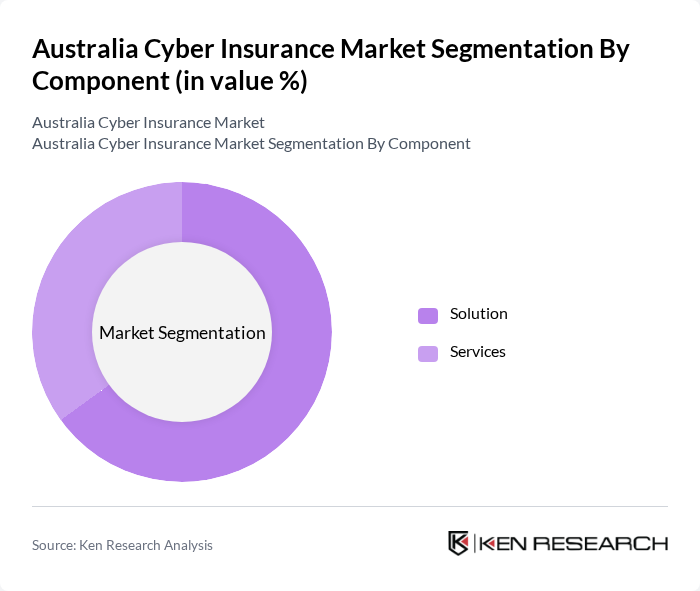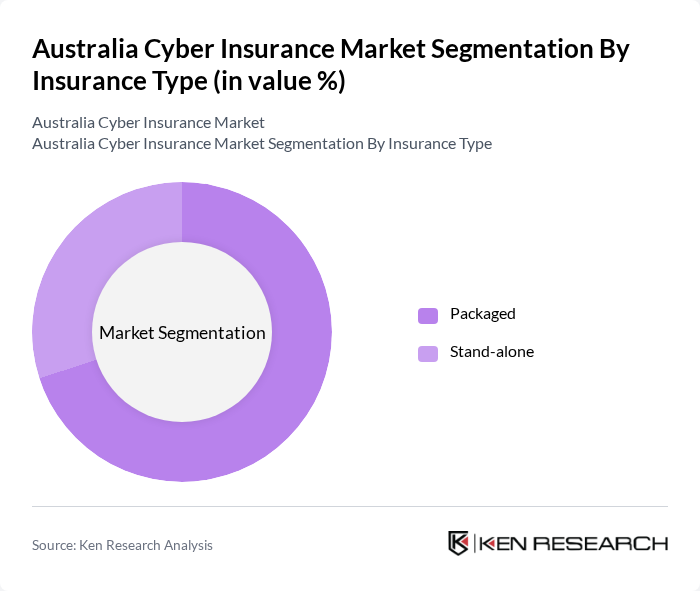Region:Asia
Author(s):Shubham
Product Code:KRAA3622
Pages:80
Published On:September 2025

By Component:

The components of the market include solutions and services. The solution segment is currently leading the market due to the increasing adoption of advanced cybersecurity technologies and software that help organizations mitigate risks. Businesses are investing in comprehensive solutions that not only provide insurance coverage but also enhance their overall cybersecurity posture. The services segment, while growing, is primarily focused on risk assessment and incident response, which are critical for organizations looking to manage their cyber risks effectively.
By Insurance Type:

The insurance types in the market are packaged and stand-alone. The packaged insurance type is dominating the market as it offers comprehensive coverage that appeals to a wide range of businesses, particularly small and medium enterprises (SMEs) that prefer bundled solutions for cost-effectiveness. Stand-alone policies are also gaining traction, especially among larger enterprises that require tailored coverage to meet specific risks. However, the packaged segment remains the preferred choice due to its convenience and broader coverage options.
The Australia Cyber Insurance Market is characterized by a dynamic mix of regional and international players. Leading participants such as QBE Insurance Group Limited, Suncorp Group Limited, Allianz Australia Insurance Limited, Chubb Limited, AIG Australia Limited, Zurich Australian Insurance Limited, Coalition Inc., CFC Underwriting Limited, Hiscox Australia, Berkley Insurance Company, Liberty Specialty Markets, Mitsui Sumitomo Insurance, Vero Insurance Limited, Aon plc, Marsh & McLennan Companies, Inc. contribute to innovation, geographic expansion, and service delivery in this space.
The future of the Australia cyber insurance market appears promising, driven by increasing digitalization and a growing emphasis on cybersecurity. As businesses continue to adopt advanced technologies, the demand for comprehensive cyber insurance solutions is expected to rise. Additionally, the integration of artificial intelligence in risk assessment and the development of customized insurance products will enhance market offerings, enabling organizations to better manage their cyber risk exposure and ensure robust protection against potential threats.
| Segment | Sub-Segments |
|---|---|
| By Component | Solution Services |
| By Insurance Type | Packaged Stand-alone |
| By Organization Size | Small and Medium Enterprises Large Enterprises |
| By End-Use Industry | BFSI (Banking, Financial Services and Insurance) Healthcare IT and Telecom Retail Others |
| By Regional Markets | Australia Capital Territory & New South Wales Victoria & Tasmania Queensland Northern Territory & Southern Australia Western Australia |
| Scope Item/Segment | Sample Size | Target Respondent Profiles |
|---|---|---|
| Financial Services Cyber Insurance | 100 | Risk Managers, Compliance Officers |
| Healthcare Sector Cyber Coverage | 80 | IT Security Directors, Insurance Brokers |
| Retail Industry Cyber Risk Management | 70 | Operations Managers, Cybersecurity Analysts |
| SME Cyber Insurance Adoption | 90 | Business Owners, Financial Advisors |
| Government and Public Sector Cyber Policies | 60 | Policy Makers, IT Governance Officers |
The Australia Cyber Insurance Market is valued at approximately USD 400 million, reflecting significant growth driven by increasing cyberattacks, heightened awareness of cybersecurity risks, and regulatory requirements for data protection among businesses.